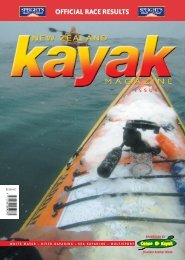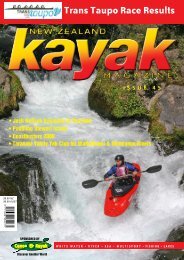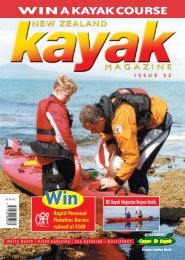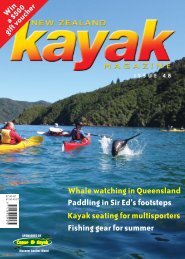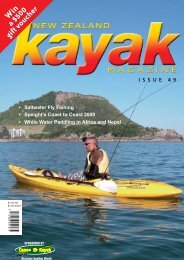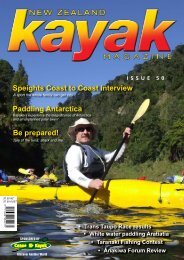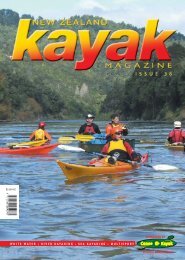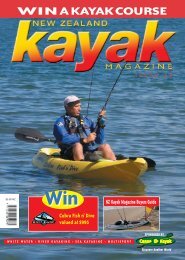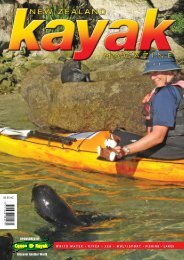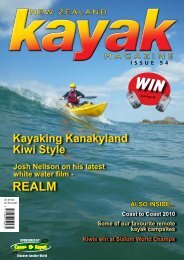kayaking the pacific islands. - Canoe & Kayak
kayaking the pacific islands. - Canoe & Kayak
kayaking the pacific islands. - Canoe & Kayak
You also want an ePaper? Increase the reach of your titles
YUMPU automatically turns print PDFs into web optimized ePapers that Google loves.
Loads on roof racks by James Fitness<br />
Transport Authorities know that ever more kayaks are<br />
being carried on our roads. This may cause you grief.<br />
Nicholas reports an incident<br />
We came back from Mt Maunganui carrying a Qk Tasman Express, a Perception<br />
Eco Bezhig and a Bliss Stick MAC1 on my roof racks. With a flag attached <strong>the</strong><br />
load overhung <strong>the</strong> car’s tail by about 1 metre. But as usual with weekend<br />
<strong>kayaking</strong> we were behind time and driving home in <strong>the</strong> dark. Leaving<br />
Hunterville we were pulled over by a police officer for not having a light on<br />
our overhanging load. Luckily for us <strong>the</strong> officer was in a nice mood and let us<br />
off <strong>the</strong> $350 fine with a warning.<br />
He suggested that all we needed was a bike light and, since our flag was faded<br />
and thrashed from lots of use, we should probably get a new one.<br />
Nicholas, finding no information on <strong>the</strong> regulations, asked NZ <strong>Kayak</strong> Magazine<br />
for help.<br />
The bare facts are;<br />
Regulations on overhanging loads.<br />
If a load extends more than one metre beyond <strong>the</strong> front or rear, or 200mm<br />
beyond <strong>the</strong> sides of your vehicle, during daylight you must attach: flags<br />
(coloured white or fluorescent red, orange or yellow, at least 400 mm long<br />
by 300 mm wide)<br />
or<br />
Standard hazard warning panels (coloured yellow/green with an orange stripe,<br />
at least 400 mm long by 300 mm wide).<br />
During <strong>the</strong> hours of darkness, you must have lights on <strong>the</strong> load visible in<br />
clear wea<strong>the</strong>r for at least 200 metres:<br />
at <strong>the</strong> rear and facing backward, coloured red (if <strong>the</strong> load extends sideways<br />
or to <strong>the</strong> rear)<br />
at <strong>the</strong> front and facing forward, coloured white or amber (if <strong>the</strong> load extends<br />
sideways or forwards)<br />
(reference: www.ltsa.govt.nz/road-user-safety/motorists/glovebox-guide)<br />
Suggestions<br />
Before you buy a roof rack, check <strong>the</strong> weight your vehicle can safely carry<br />
on its roof. (Look in <strong>the</strong> vehicle’s manual) Check <strong>the</strong> roof rack’s safe load.<br />
Consult your roof rack specialist to find <strong>the</strong> system which best suits your<br />
vehicle and <strong>the</strong> accessories needed for your specific load.<br />
While weight will seldom be your problem, bulkiness and length are very<br />
likely to cause trouble.<br />
When a kayak overhangs, and regardless of <strong>the</strong> accessories used to mount<br />
it, you must tie <strong>the</strong> bow to <strong>the</strong> front of <strong>the</strong> car and <strong>the</strong> stern to <strong>the</strong> back to<br />
prevent <strong>the</strong> boat from lifting in <strong>the</strong> wind. There is huge leverage at <strong>the</strong> end<br />
of a kayak which could well rip your roof rack off! And no, this will not be<br />
covered by warranty.<br />
The normal spacing of roof racks to suit <strong>the</strong> shape kayaks is about 700mm.<br />
Any fur<strong>the</strong>r apart and your kayak will touch <strong>the</strong> roof between <strong>the</strong> bars.<br />
The accessories you’ll need will depend on <strong>the</strong> number of boats to be carried,<br />
what <strong>the</strong> kayak is made of, and what else you are carrying.<br />
If you are carrying composite boats you should invariably use a set of kayak<br />
cradles. These 4 pads hold <strong>the</strong> kayak firmly in place without <strong>the</strong> need to overtighten<br />
<strong>the</strong> load straps and cause compression cracks. There is often space<br />
on <strong>the</strong> roof rack to fit two cradles alongside each o<strong>the</strong>r for two kayaks, or to<br />
hold one kayak and a box and bike carrier for <strong>the</strong> multisporters.<br />
Upright bars are more practical when carrying up to 4 boats. Stack <strong>the</strong>m on<br />
ei<strong>the</strong>r side of <strong>the</strong> bars, with hulls facing hulls to prevent indentation from<br />
<strong>the</strong> cockpit shapes.<br />
Obviously, <strong>the</strong> more you have on your roof, <strong>the</strong> sturdier <strong>the</strong> straps will need<br />
to be. Bungy cords are never substantial enough.<br />
Remember that ...<br />
• <strong>the</strong> more weight on <strong>the</strong> roof, <strong>the</strong> less weight can be carried inside your<br />
vehicle.<br />
• roof racks increase wind resistance and buffeting.<br />
• you may need to travel slower and your vehicle will use more fuel.<br />
ne <strong>Kayak</strong>s<br />
1 metre<br />
Maximum forward overhang 3 metres<br />
(measured from front of seat)<br />
1 metre<br />
Maximum rear<br />
overhang 4 metres<br />
Designers & Constructors of Multisport<br />
& Adventure Racing <strong>Kayak</strong>s<br />
Phone 06 875 0043 Fax 06 875 0983<br />
E-mail:- kevin@ruahinekayaks.co.nz<br />
P O Box 11146 Hastings<br />
Website:-www.ruahinekayaks.co.nz<br />
This fast, stable kayak is designed<br />
for <strong>the</strong> larger paddler looking for<br />
a longer, stable boat.<br />
Gladiator<br />
ISSUE FORTYsix• 2008 11



